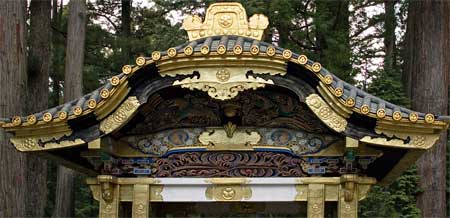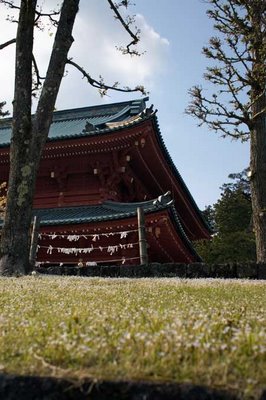
This post covers my trip South from Koriyama to Nikko, an ancient shrine complex. (Really spelt Nikkou, meaning sunlight.) Kumama, Shigetaro (her oldest son) and myself started off (somewhat) early to arrive in Nikkou before lunch. The day was extremely beautiful as the image above will a test to. Not too cool and not too warm; the normally lush green mountains were just starting to burst into leaf. This meant that as we drove to Nikko we encountered nearly every possible shade of green. While I was slightly late to see the full glory of Sakura (cherry blossoms) in Koriyama, every other possible flowering tree was in full bloom, as were some late mountain Sakura as well. I timed my trip perfectly.

Some history: Nikko is the burial place of Tokugawa Ieyasu (1543-1616) who in 1600 at the Battle of Sekigahara unified Japan under the Emperor and established the Tokugawa shogunate who ruled Japan (through the Emperor) until the Meiji Restoration in 1868. It's a complicated bit of history. His son and grandson are also buried at the site. A person with so much power being buried there caused basically a little economy of its own to grow based on associated shines and whatnot. Most of the shines and temples are jewels in their own right if not significantly older that what you would see in Kansai.
The setting is really amazing. Tucked away on the side of a mountain, all set under massive (really massive) cedar trees makes for a stunning impact on the visitor. It was actually my second time visiting the site (the first time being six years ago), though it was Kumama and Shigetaro's first: Making me realize how much Japanese culture I have been exposed too. Being Golden Week there were lots of tourists from Tokyo. I have become accustom to Japanese crowds and really only worry about them if I am carrying large luggage. It was refreshing to try to imagine what the site was like decades ago when the only inhabitants of the forest were the caretaker monks of the shrines and temples.
 There is a huge array of temples to choose at the site but I wanted to focus on two smaller artifacts seen at Nikko that will entertain the visitor. The first is the very famous carving three monkeys. We know it as "See no Evil. Hear no Evil. Say no Evil," here it translates as: "Mizaru. Kikazara. Iwazaru." The sculpture itself is quite small and high up, set among a whole wall of carvings. I don't know if this is the first instance of the subject in Japan or why it's famous, but everyone was taking pictures of it.
There is a huge array of temples to choose at the site but I wanted to focus on two smaller artifacts seen at Nikko that will entertain the visitor. The first is the very famous carving three monkeys. We know it as "See no Evil. Hear no Evil. Say no Evil," here it translates as: "Mizaru. Kikazara. Iwazaru." The sculpture itself is quite small and high up, set among a whole wall of carvings. I don't know if this is the first instance of the subject in Japan or why it's famous, but everyone was taking pictures of it. Another smaller, but perhaps more famous sculpture is the "Nemuri Neko" or Sleeping Cat. About life-size and placed above a door in an amazingly ornate gate; it's well placed to maximize a bottleneck hundreds of years later as crowds try to take a picture of it and enter the gate at the same time.
Another smaller, but perhaps more famous sculpture is the "Nemuri Neko" or Sleeping Cat. About life-size and placed above a door in an amazingly ornate gate; it's well placed to maximize a bottleneck hundreds of years later as crowds try to take a picture of it and enter the gate at the same time.
Lastly the grave of Tokugawa himself. Despite having to stand in a long line the environment and wait is wholly relaxing (as compared to, say, waiting in traffic); there's lots to look at and absorb. After having wound your way further up the mountain you can shuffle past the grave in relative peace. So after braving the crowds and the gift stalls and the parking lot you can stand, and see, and hear, and touch, and experience something that is wholly Japanese much as it would have been hundreds of years ago. Great place; I would highly recommend it.

日光を見なければ、けっこうと言うな。
No comments:
Post a Comment